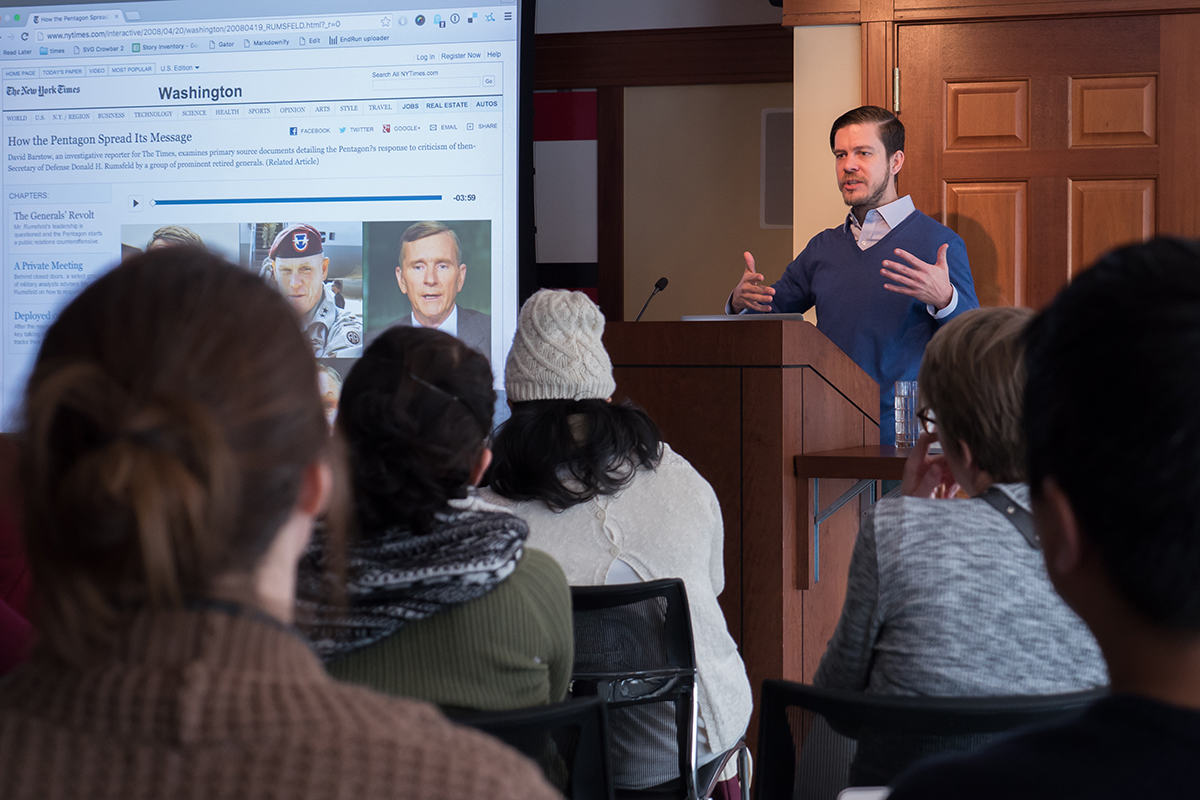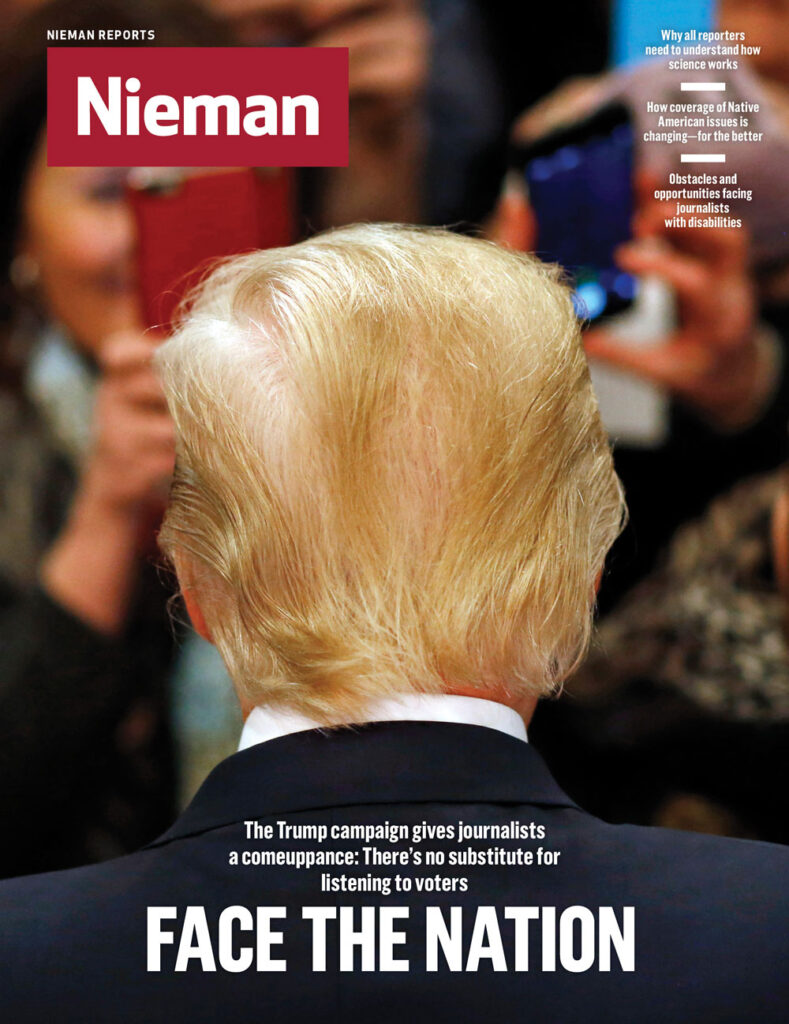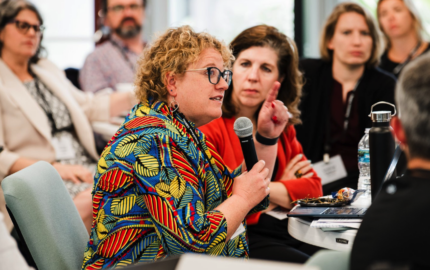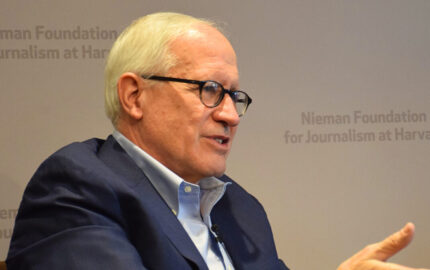For a guy with a bachelor’s degree in computer science and a master’s in multimedia journalism, you might think Gabriel Dance wouldn’t be all that enamored of non-fiction prose. But he still ranks the written word above other means of communication. “Writing is our most flexible, fastest, and most dynamic form of storytelling,” he says.
Dance began his career at The New York Times in 2006 just as the paper was merging its print and digital staffs. He became chief multimedia producer and subsequently moved to the role of interactive editor at The Guardian, where he was part of the team that received a Pulitzer Prize for Public Service for coverage of the U.S. National Security Agency’s secret surveillance program. Dance is now managing editor of The Marshall Project, a nonprofit investigative journalism site focused on the criminal justice system. “Technology and journalism right now are so intertwined that they're kind of this spinning comet that is sailing into the future,” he says. “We don't know where one will take the other, but they're both driving one another right now.” Dance spoke at the Nieman Foundation in January. Edited excerpts:
On the four types of people encountered in newsrooms
At The New York Times, where I was on the team that did some of the first experiments with streaming video, interactive graphics, and user generated content, the people I met fit in one of four categories, technologically speaking. The Natives—like Aron Pilhofer, Derek Willis, Scott Klein, and Andrew DeVigal—are people who already understood the implications of technology. The second group is the Naturals, people like Jim Roberts. When I arrived, Jim, who’d already been there for 20 years, was head of the digital newsroom. He was as old school journalist as you could get. Jim was not operating from a place of fear; he was operating from a place of excitement. He saw the potential in everything, even though he didn't understand almost any of it at the beginning. He surrounded himself with smart people and people who he thought would help him learn.
I like to call the third group the Collaborators. They are my favorite group to work with. They are not necessarily interested in learning how to program, do databases, or do the interactives themselves, but they’re excited about working with people who are good at those kinds of things in order to do better projects. They often cause me to have ideas I never would have had. Collaborators are often very good at what they do so they don't feel threatened by another person coming in saying, "I want to do work with you." The last group I met I call the Fearful. That’s a dangerous group to be in. The Fearful operate from a place of–well–fear. They're not sure what's going on, they're not sure how they're going to keep their job, they're not sure of the new technology.
On creating platform-specific content
The video landscape is hyper competitive nowadays. Video also has one of the few advertising schemes that is still paying dividends. The problem is, it's super hard to crack.
There are two things I find interesting about video. One is virtual reality, such as Oculus Rift. It’s very immersive. That's going to be a tremendously exciting and interesting place for video. The other thing is social media. Video is going crazy on social media, which is dominated by things like Facebook, and I can't overemphasize how important Facebook is right now to journalism. Websites get huge amounts of their traffic through Facebook. It can turn switches off and on that either reduce that traffic to a trickle or open the spigot to a fire hose.
Creating content for Facebook or Snapchat—or whatever—needs to be content for that particular platform
The Marshall Project, in partnership with ProPublica, recently published "An Unbelievable Story of Rape," written by Ken Armstrong and T. Christian Miller. It was an interesting, long, complicated, wonderfully written investigation into a woman who said she was raped, then said she wasn't raped, and the subsequent police investigation around that. We built a 30-second video teaser for Facebook, which got very little attention. Yet the story got crazy good traffic. I think the story is probably the most popular thing The Marshall Project has ever published. This one happens to be one of the best things we've published, but things get crazy traffic for a variety of reasons. What we took away from the experience is that creating content for Facebook or Snapchat—or whatever—needs to be content for that particular platform. People on Facebook didn’t engage with our video in a way that says, "Oh, here's a teaser. Let me follow that teaser back to the website." They will watch your video on Facebook, and they want to stay on Facebook and finish consuming it there or stay on Snapchat and finish consuming it there. That's fine, especially for a nonprofit like The Marshall Project. We don't care where you see our content because we don't do advertising.
What we'll need to do is hire somebody to produce content specifically for these platforms. That is a real skill, and it's not the same skill as writing an 800-word story or a 5,000-word story. It's not the same skill as producing a 10-minute documentary. It's not the same skill as doing an interactive graphic. It's a skill of knowing how to engage people, knowing how to quickly get their attention and maintain it, by knowing what they're interested in.
On the success of AJ+
Some place that's doing wonderfully with this right now is AJ+. This part of AJ+ is under the leadership of Jigar Mehta, who was at The New York Times while I was there. What Jigar is doing with his social media team at AJ+ is the envy of the industry. A video they posted called "Flint's Drinking Water Poisoned Kids" has over two million views. If you had shown me that video a year ago, I would have been like, "What the hell is going on? Why are they printing all the copy? Why aren't they talking? Where is the voice over? Where is the narrative?" Facebook started auto playing videos when you're in your feed. What's happening is people don't have their headphones in, and they're not listening to their Facebook while they're scrolling through it, so the audio appears as text on the screen.
Jigar has a few rules. One is that you have to catch somebody's attention in the first five seconds, which is terrifying. Two is that you have to use these short, punchy captions in order to get people to continue to watch them. This is what they're doing on probably 80 percent of their videos. This video is built for Facebook. AJ+ doesn't even have a website. Writing for the ear is much different than writing for print. My understanding is that these videos with the copy on them are going gangbusters. They're usually 45 to 90 seconds long.
Video editing is like copy editing. You can take something that nobody would want to watch and make it beautiful just by being technically very good at it. Then you need a video editor on the content side to make sure the story is being told well. That person has to be somebody like Jigar, who has a deep background in documentary filmmaking and traditional video.
On Facebook
Facebook does not make a ton of money off of the journalism business. They're worried about much bigger things. If a business reason came along to change how Facebook treats journalism, Facebook wouldn’t hesitate. To be honest, Facebook is 90 percent of what matters. Twitter is a wonderful place to chat with our friends, to have influencers tweet your story. It drives extremely little traffic, especially in comparison to Facebook. We run a lot of analytics on what stories do well on our Facebook and, unsurprisingly, it’s policing, race, and rape. We can publish a story on policy that affects way more people, and nobody's going to read it. Nobody's going to engage with it in the same way.
On why there is no 'template' for great graphics
A lot of people will look at excellent graphics and say, "OK, this is great. What's the template for this, or what tool do you use to build that?" I say, "Show me the template or the tool for that Pulitzer Prize winning investigation. Show me the tool you used to build that 'Unbelievable Story of Rape' piece.” There isn't one. These are all works of journalism, crafted things.




